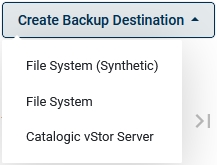DD Boost
Prerequisites
To create a new storage unit (or use an existing one) you can use Power Protect DD Storage Unit Creator
For the basic setup of file systems on the Node, check File system.
Creating a Synthetic Filesystem Backup Destination
Select File System from Backup Destinations.

Select Create Backup Destination -> File System (Synthetic).

Configuration is similar to a regular filesystem.
Host: address of Data Domain server
Account name and password: credentials for Data Domain
Storage unit: storage unit name from Data Domain
Storage path: path for storing backups.
Optionally, you can switch on "Data Domain is mounted to a different directory than backup destination path" and set up a different Storage path than the DD mount path.
Power Protect DD Storage Unit Creator
This configuration wizard will guide you through creating a storage unit to use as a backup destination for your protected data. You can create a new user, a new storage unit, or use existing ones as well.

To use the wizard, you need to prepare the following:
PowerProtect DD address
Administrator username
Administrator password
Follow the steps of the wizard to configure the storage unit and user. After you will go through all the steps, wizard will fill up all the necessary fields in the form.
Retention lock
The retention lock option allows you to protect your backups from any changes for a certain number of days. It requires Data Domain retention lock to be enabled. It must be set to Manual mode and allow you to set the required retention lock (it is limited by Data Domain):
